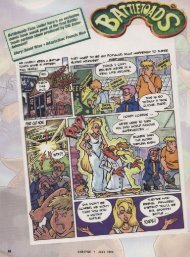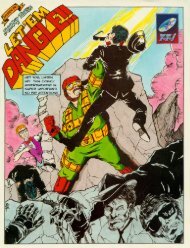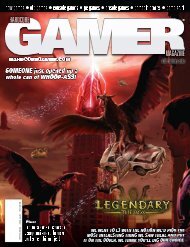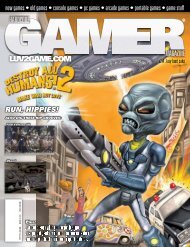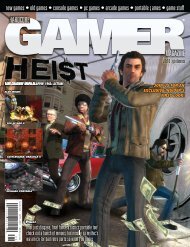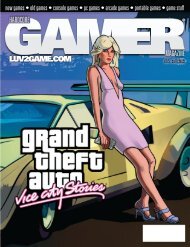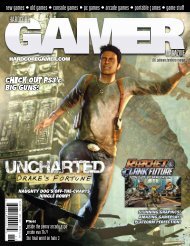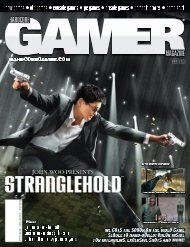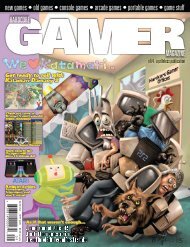Download - Defunct Games
Download - Defunct Games
Download - Defunct Games
You also want an ePaper? Increase the reach of your titles
YUMPU automatically turns print PDFs into web optimized ePapers that Google loves.
Publisher : Konami<br />
Developer : Konami<br />
Release Date : 12/5/2006<br />
Rating : Teen<br />
3.75 of 5<br />
Review by Wanderer<br />
Genre(s) : Whip it Right...<br />
Category : ...Like You Should<br />
# of players : 1-2<br />
For the last few years, the best titles in the<br />
Castlevania franchise have been 2D portable<br />
games (although Curse of Darkness was decent),<br />
all of which are attempts to live up to the<br />
standard set by Symphony of the Night.<br />
They all follow the same basic formula. You<br />
start at the entrance of the castle, and must<br />
explore it to find the relics you need to get further<br />
into the building. These relics are guarded by bosses.<br />
Eventually, you’ll run into either Dracula or some<br />
schmuck who’s trying to resurrect Dracula and who<br />
will succeed three seconds after you find him. Kill<br />
Dracula... with violence. Watch the castle collapse.<br />
Bonus modes are unlocked. See you next year, everyone!<br />
I’m ordinarily fine with this. Now that I’ve beaten Portrait<br />
of Ruin, though, it’s becoming obvious that Konami has gone<br />
about as far as it can go with this formula. Portrait has<br />
perfected the formula, but if you’ve played the other five<br />
“Metroidvanias” as much as I have, it’s very much old hat.<br />
Portrait is set in 1944, at the height of World War II. The<br />
worldwide chaos has caused Dracula’s castle to reappear,<br />
and two hunters rush to the scene. One is Jonathan Morris,<br />
the son of John Morris from Castlevania: Bloodlines and the wielder<br />
of the mysteriously-depowered Vampire Killer whip; the other is his<br />
friend Charlotte Aulin, a powerful magician.<br />
Inside the castle, they find a series of magical landscape paintings, created<br />
by an insane vampire named Breuner. Each painting is kind of a pocket<br />
dimension, making each painting an area you can explore. This allows for<br />
a little variety in the game’s backgrounds, which is a nice touch.<br />
You control both Jonathan and Charlotte simultaneously, which adds<br />
some new gameplay and an awesome online co-op mode. A lot of<br />
the issues from Dawn have been improved as well; it’s much more<br />
challenging, the enemies’ item drop rate is much higher, the menus<br />
are better-designed, you have more accessory slots, and you can go<br />
online to purchase items from other players worldwide. You can also<br />
2nd opinion by Lynxara • Alternate Rating : 4 of 5<br />
find an amazing variety of upgradable subweapons<br />
and nonupgradable spells, which makes the game<br />
almost as customizable as Dawn.<br />
The biggest problem that Portrait has, in fact,<br />
is that it’s too much like its predecessors. If<br />
you played Dawn of Sorrow, Portrait will seem<br />
oddly familiar, even with its new features. You<br />
get many of the same special abilities, many<br />
of the subweapons are functionally identical<br />
to what you’ve had in past games, they’ve<br />
recycled a lot of sprites (for no real reason,<br />
Portrait is full of shoutouts to Symphony),<br />
and even a couple of the bosses are the<br />
same. Other series can and have gotten<br />
away with this much repetition, but<br />
we’ve gotten an exploration-based<br />
Castlevania almost every year like<br />
clockwork since the GBA launched.<br />
The series needs to break new<br />
ground.<br />
If you haven’t played as much<br />
Castlevania as I have, you should<br />
add a point onto my score. Dawn<br />
of Sorrow is one of the best<br />
games on the DS, and Portrait’s<br />
biggest problem is that it’s too much like it.<br />
Obsessive Castlevania fans (i.e. me) may feel<br />
like they’ve been here before, but other gamers<br />
(and me too, honestly) should have a blast.<br />
Rating : 3.5 of 5<br />
PoR is almost a perfect evolution of DoS’s spin on the Castlevania formula, but the level and boss<br />
designs are hopelessly trite. It’s a shame; the new online features and co-op are brilliant.<br />
58_REVIEW_PORTRAIT OF RUIN HARDCORE GAMER MAGAZINE_VOLUME 2_ISSUE 8_FISSION MAILED<br />
If you’re like me and have already<br />
played Atelier Iris and Atelier Iris 2,<br />
you may want to take half a point off of<br />
my score. This is because Ar tonelico is,<br />
functionally, the same game you’ve already<br />
played twice before. The characters are quirky<br />
and shallow, the dungeon crawls are almost<br />
laughably easy, and the game’s real challenge<br />
is primarily in collecting all of the many items<br />
you can synthesize. Very little is different<br />
aside from the names and the dungeon<br />
environments, and what new elements<br />
are present feel more like elaborations<br />
on the core formula than real change.<br />
In addition to items, Ar tonelico lets<br />
you collect power-ups and costumes<br />
for your three song maidens, and<br />
“conversations” that serve to develop<br />
their personalities. Your song maiden (or<br />
“Reyvateil”) is in theory the heart of Ar tonelico’s<br />
gameplay; you can only ever have one in your party<br />
at a time, and she uses “song magic” either to<br />
attack enemies or buff up your party in various<br />
ways. Other characters are more general types of<br />
attackers, or protect your Reyvateil from damage.<br />
All this is really a bit academic, though. You’ll never<br />
need to exploit the finer points of the combat engine<br />
to accomplish anything other than maybe trying to<br />
get extra item drops from enemies. Fortunately, Ar<br />
tonelico limits random encounters with a depleting<br />
2nd opinion by KouAidou • Alternate Rating : 3.5 of 5<br />
This game is delighfully weird, but it really needed deeper characters to make the system work.<br />
Still, I can’t hate a game with Japanese gangsta rap on its OST. Can you?<br />
HARDCORE GAMER MAGAZINE_VOLUME 2_ISSUE 8_FISSION MAILED<br />
Review by Lynxara<br />
Publisher : NIS America Genre(s) : RPG<br />
Developer : Gust<br />
Category : Girls<br />
Release Date : 02/06/07 # of players : 1<br />
Rating : Teen (Language, Mild Fantasy Violence, Suggestive Themes)<br />
gauge as in Atelier Iris 2, so you never really have to fight more than<br />
you want to. You can use items you’ve acquired for a variety of<br />
purposes, ranging from customizing weapons to synthesizing new<br />
items entirely. You can in turn use items either in combat, or<br />
to create other items. This is the part of the game that can get<br />
addictive, as the item synthesis system is even better in this title<br />
than it was in the alchemy-driven Atelier games.<br />
By fighting battles you also accumulate Dive Points, and you can<br />
then go to Dive Centers and cash them in to enter your Reyvateil’s<br />
Cosmosphere. The Cosmosphere is simply, well, her mind. Once<br />
there, you engage in story events that unlock extra costumes and new<br />
powers for her. How deep you can Dive is only limited by how many<br />
Dive Points you have, which is a problem. It’s very easy to trigger Dive<br />
events that reference story events you’ve yet to play through.<br />
Even more of a problem: your three Reyvateils just aren’t<br />
interesting characters. The datesim-style gameplay is somewhat<br />
interesting as a gimmick, but doesn’t really work without a<br />
compelling cast. How deep you Dive with given characters ultimately<br />
just feels like a means to the end of collecting all seven of the<br />
game’s endings. It should be mentioned that you do unlock some<br />
“suggestive” still art of the girls later on in the game as a reward<br />
for deep Diving, but the imagery is extremely tame compared to,<br />
say, DoAXVB. Make of that what you will.<br />
Ar tonelico is not a bad game, although it does feel less interesting<br />
than it should be. It’s primarily a collecting sim with a vestigial RPG<br />
attached, and most of the enjoyment in the game comes from the simlike<br />
elements and beautiful 2D sprites. The soundtrack is far and away<br />
the best it’s been in any Gust game to date, and is almost worth the<br />
price of admission by itself. While the localization is a bit disappointing<br />
as NIS-A efforts go, Ar tonelico still has some good gags and an intact<br />
Japanese voice track to offer. It’s easily a better play than either of<br />
the Atelier games, but still frustratingly similar to them.<br />
Rating : 3.5 of 5<br />
3.5 of 5<br />
AR TONELICO: MELODY OF ELEMIA_REVIEW_59



